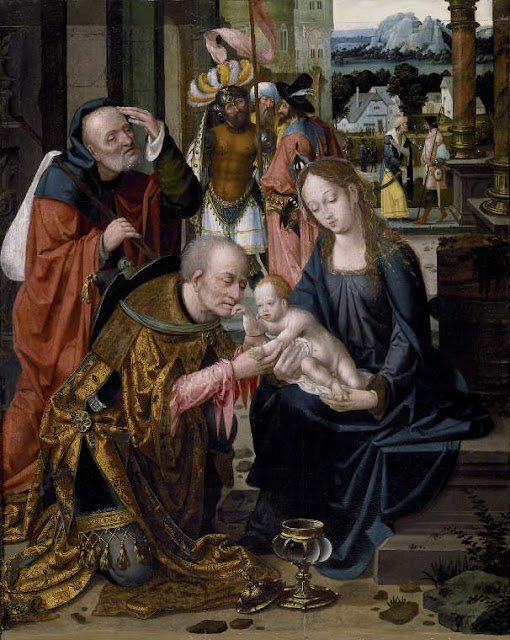 |
| Anonymous artist working in Florence Martyrdom of St Sebastian ca. 1450-1550 oil on panel Fitzwilliam Museum, Cambridge |
 |
| Filippino Lippi Nativity with two Angels ca. 1490-95 tempera on panel National Galleries of Scotland |
"The central figure of the Virgin Mary, kneeling in adoration of the Christ Child, derives from a compositional type invented by Filippino Lippi's father, Filippo Lippi. Filippino elaborated the theme by including the seated figure of Joseph and two angels who hold up Mary's mantel. This unusual gesture emphasises the linear patterns made by the drapery folds. The influence of Netherlandish painting is evident in the turreted towers and landscape background. The proportions of this small panel suggest that it was originally painted as part of a predella for an altarpiece."
– curator's notes from the National Galleries of Scotland
 |
| Domenico Ghirlandaio Nativity- before 1494 tempera on panel Fitzwilliam Museum, Cambridge |
 |
| Francesco Botticini Virgin adoring the Child before 1497 tempera on panel Fitzwilliam Museum, Cambridge |
 |
| Anonymous artist working in Germany St Christopher meeting the Devil ca. 1500-1600 oil on panel Fitzwilliam Museum, Cambridge |
 |
| Sodoma St George and the Dragon ca. 1518 oil on panel National Gallery of Art, Washington DC |
 |
| Anonymous artist working in the Netherlands Portrait of a man ca. 1520-25 oil on panel National Galleries of Scotland |
"Although currently not attributed, this portrait was clearly painted by a Netherlandish artist of considerable skill. On the basis of the dress, composition and execution, it can be dated to around 1520-25. It is stylistically very close to the work of Jan Gossaert (also known as Mabuse), but could possibly be an early painting by Jan Cornelisz Vermeyen. The portrait has a particularly distinguished provenance. It was owned by the controversial collector and writer Richard Payne Knight before 1800, and stayed in the family [until acquired by the museum in 2005]."
– curator's notes from the National Galleries of Scotland
"Bugiardini almost certainly painted this altarpiece for Bindo Altoviti, a Florentine banker who was one of the greatest patrons of his day. Altoviti commissioned it for a private chapel dedicated to the Magdalen that he founded in the town of Cappiano in the Arno valley in 1523. Remarkably, the painting has survived in its original frame – the Altoviti arms are on the base of the pilasters – probably designed by the talented architect and woodworker Baccio d'Agnolo and painted by a specialist in ornament. The artist achieved a harmonious synthesis of space, figures, and gestures, making this a grand statement of Florentine Renaissance painting."
– curator's notes from the Metropolitan Museum of Art
"Riding a grey and sheltered by a baldachin, Francis, duke of Anjou, son of the French King Henri II, entered Antwerp on 19 February 1582. The triumphal arch was erected specially for this occasion. The Dutch rebels had invited Anjou to be their ruler instead of King Philip II of Spain, whom they no longer recognized as their sovereign. The pomp and circumstance notwithstanding, this intention came to naught. Antwerp fell into Spanish hands in 1585, and the Northern Netherlands became a republic in 1588."
– curator's notes from the Rijksmuseum
 |
| Giuliano di Simone Bugiardini Madonna and Child enthroned with Saints Mary Magdalen and John the Baptist ca. 1523 oil on panel Metropolitan Museum of Art, New York |
"Bugiardini almost certainly painted this altarpiece for Bindo Altoviti, a Florentine banker who was one of the greatest patrons of his day. Altoviti commissioned it for a private chapel dedicated to the Magdalen that he founded in the town of Cappiano in the Arno valley in 1523. Remarkably, the painting has survived in its original frame – the Altoviti arms are on the base of the pilasters – probably designed by the talented architect and woodworker Baccio d'Agnolo and painted by a specialist in ornament. The artist achieved a harmonious synthesis of space, figures, and gestures, making this a grand statement of Florentine Renaissance painting."
– curator's notes from the Metropolitan Museum of Art
 |
| Anonymous artist working in the Netherlands Bacchus and Ariadne ca. 1540-50 oil on panel National Galleries of Scotland |
 |
| school of Joos van Cleve Adoration of the Kings before 1540 oil on panel Fitzwilliam Museum, Cambridge |
 |
| Anthonis Mor Portrait of a man as St Sebastian before 1577 oil on panel Fitzwilliam Museum, Cambridge |
 |
| Monogrammist MHVH Joyous Entry in 1582 of the Duke of Anjou into Antwerp, with Triumphal Arch on St. Jan's Bridge ca. 1582 oil on panel Rijksmuseum, Amsterdam |
"Riding a grey and sheltered by a baldachin, Francis, duke of Anjou, son of the French King Henri II, entered Antwerp on 19 February 1582. The triumphal arch was erected specially for this occasion. The Dutch rebels had invited Anjou to be their ruler instead of King Philip II of Spain, whom they no longer recognized as their sovereign. The pomp and circumstance notwithstanding, this intention came to naught. Antwerp fell into Spanish hands in 1585, and the Northern Netherlands became a republic in 1588."
– curator's notes from the Rijksmuseum
 |
| Crispin van den Broeck Two young men before 1590 oil on panel Fitzwilliam Museum, Cambridge |
 |
| Cigoli Pietà with St John the Evangelist and the Magdalene ca. 1599-1600 oil on panel Fondazione Musei Senesi |